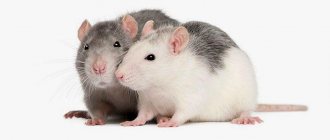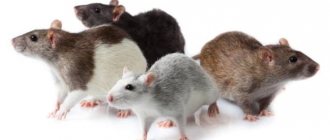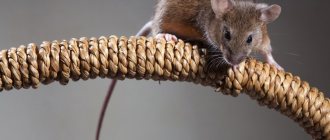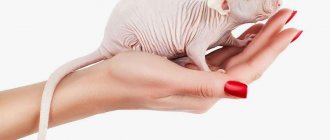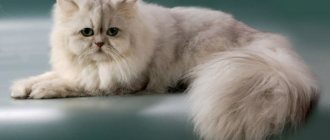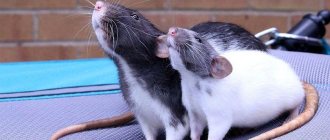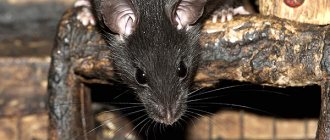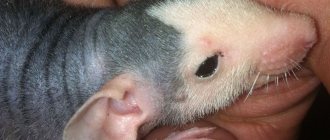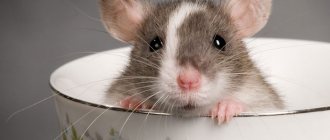Before you get a decorative pet rat, you need to study the list of foods that you can feed your rat. It is believed that rats are omnivores. Gardeners who often struggle with rodents are especially sure of this. Summer residents try in every way to kill rodents, often using poison for this. But the rats survive and continue to damage the furniture and chew up all the food they find.
But this is typical only for wild rats that live in the wild. The digestive system of domestic rats is much weaker than that of wild rats. Therefore, the owner must know what can be fed to the rat and what cannot be given to it.
Types of decorative rats
There are different breeds of decorative rats. According to the type of wool they are divided into:
- standard, with short and smooth pile;
- rexes with mustaches and wavy fur;
- satin - with shiny silky fur;
- sphinxes are naked rats;
- Dumbo - individuals are distinguished by round, low-set ears, reminiscent of Mickey Mouse.
Animal colors are divided into subspecies:
- homogeneous: there are pure black, white, chocolate, blue, albino and others;
- heterogeneous: rats have Siamese, Himalayan, sable, silver and other colors;
- variegated: composed of several colors.
Rat food: which one is better?
Grain mixture is the basis of the diet of domestic rats. I advise you to buy only high-quality food, and if this is not possible, prepare the mixture yourself. Unfortunately, domestic inexpensive food has a very poor composition. They consist mainly of oats.
I categorically do not recommend buying food that is stored in cardboard boxes (not airtight), especially in hypermarkets. A rat can easily be poisoned by such food if it was standing, for example, next to washing powder. Opt for imported food in sealed packaging.
Of the two foods, the choice is obvious in favor of Little One, although this is far from the best food for rats
Here are some high-quality foods that can be safely offered to decorative rats:
- Versel-Laga Rat Nature;
- Vitacraft Menu Vital;
- Beaphar Xtra Vital Rat or Care+ Rat Food;
- Vitapol Karma Premium;
- JR Farm Ratten-Schmaus.
Please note that in addition to regular grain mixtures, there are granulated foods for rats. They are similar to complete food for cats and dogs - homogeneous solid “crackers”. Granular feed does not differ from regular feed in composition. They are convenient in the case of selective eating - if rats select seeds and other goodies from the food, leaving the grain uneaten.
Rat food
The basis of the diet should always be cereals: wheat, rye, barley, oats.
Keeping decorative rats
Domestic decorative rats are rodents; they are cared for and kept in metal cages, because they are the strongest and most durable. It is better not to keep animals in plastic and wooden structures. It is also not recommended to place them in aquariums - they are difficult to clean, and the animals jump to a height of 40-50 cm and can escape. The house is installed in a place where there is no direct sunlight and draft, from which a rat can contract pneumonia. There is no need to place a home near the battery - dry air is harmful to animals. Optimum temperature +18-20°C.
For a decorative rat, the cage should have a size of 60x40x30 (for growth); often the house has two floors. Inside the home you need to install:
- a plastic tray with filler (preferably dry wood granules. Small sawdust can cause allergies in rats by getting into their eyes and nose. Newsprint contains harmful substances and is not suitable for use as bedding);
- stairs and tunnels, a wheel (animals love to play);
- plastic house for privacy;
- mineral stone for rodents (they sharpen their teeth);
- drinking bowl;
- 1-2 bowls;
- a cloth for sleeping or a hammock.
Dairy
The decorative rat eats dairy products with pleasure, but some animals have lactose intolerance. Regular milk should not be given to a rodent at all, but fermented milk in small quantities will not harm. However, you should not feed your pet rat sour cream, cheese or cream due to the high fat content of these products.
Animals benefit from cottage cheese, fermented baked milk, yogurt without additives and sugar, yogurt, kefir, acidophilus. All these products should have a fat content of 2-4%. Low-fat foods are less natural. “Sour milk” should be chosen with a short shelf life, preferably children’s milk or from farms.
How to care for a decorative rat?
If decorative rats live in the house, care and maintenance of them include indispensable cleaning of the cage. Drinkers and bowls need to be washed daily, remove soiled or wet bedding, food debris, and change the filler in the tray. The cage and all household items must be systematically disinfected. If you carefully care for your decorative rat, the smell from it will be almost invisible. The animals are unpretentious and easily adapt to any environmental conditions. You can sometimes let them out for a walk, but you need to keep an eye on the pet so that it doesn’t chew on valuables.
Is it possible to bathe decorative rats?
Decorative domestic rats are neat and clean animals; keeping babies requires mandatory bathing. The procedure is carried out if the animal itches or has an unpleasant odor. Shampoo from a pet store will help deal with it. For bathing, prepare a container with heated water. They put the animal in it and wash it with their hands. In this case, the rodent may scratch and bite, but some people like this procedure. When bathing, you need to pay attention so that water does not get into the rat’s ears and nose. After the procedure is completed, the animal is dried with a towel.
What a rat needs to be happy: six things that anyone who wants to have the symbol of the year should know
On average, you can buy an animal for 500 rubles
» href=»https://klops.ru/news/2019-12-17/205640-v-rossii-pered-novym-godom-spros-na-domashnih-krys-vyros-vdvoe»>demand for the 2020 symbol has increased -go - a rat. In the Kaliningrad region you can find both the bald sphinx and the husky, a rather large animal whose face pattern resembles the “mask” of dogs of the same breed. Such rodents cost up to 1,000 rubles. Ordinary decorative rats cost 100-150 rubles.
Kaliningrad biologist Natalya Danilkiv, in whose house the rats Belka and Strelka settled, named six conditions for a happy rat life.
1. Communication.
Keeping a rat alone is inhumane; the animal will wither away. He needs to communicate with his owners and other animals. A rat can make friends with a guinea pig, dog, or cat.
What to feed a decorative rat at home?
Care and maintenance of a rodent have its own nuances in nutrition. Although animals are unpretentious in food, their diet should contain as little fat as possible. Adults are fed 2 times a day, babies - 4 times. They also need clean and fresh water. What to feed a decorative rat at home:
- Grain base (wheat, oats, barley, corn, millet). High-quality balanced mixtures are sold in pet stores.
- Vegetables, fruits: white cabbage, carrots, bananas, cucumbers, apples, boiled potatoes, pumpkin, eggplants, grapes.
- Protein food (given once a week): a piece of boiled meat, cottage cheese, cheese, egg.
- Chicken bones: animals love to sharpen their teeth with them.
- In autumn and winter, it is recommended to give pets ready-made vitamins from a pet store.
Decorative rats - care and maintenance: what should not be given as food:
- chocolate, sweets, candies;
- raw beans or beans;
- smoked sausage;
- raw potatoes;
- chips;
- soda and sweet drinks;
- Brussels sprouts and red cabbage.
What grass can be given to decorative rats?
Greens should be present in the daily diet of rodents. What do decorative rats eat from grasses:
- dill;
- dandelion;
- parsley;
- cilantro;
- plantain;
- radish tops.
A little about the physiology of rats:
- Rats are nocturnal animals, but can adapt to their owner's regime
- The average lifespan of rats is 26-40 months (2-3 years)
- The average weight of an adult male is 300-500 g
- The average weight of an adult female is 225-325 g
- Body temperature 37.5-38.5 C
- Pregnancy 21-23 days
- Litter averages 6-12 rats
- Weight of the baby rat at birth is 4-6 g
- Puberty occurs at 6-8 weeks
- Approximate food intake of an adult rat per day is 15-20 g
- Approximate water consumption per adult rat per day is 22-33 ml
Decorative rats - diseases
A healthy animal is always active, it has clear eyes and shiny fur. There should be no red spots around the rodent's eyes, nose and ears. Knowing what a decorative rat looks like when properly cared for in a healthy state, if abnormalities are detected, you should consult a doctor. Rodent diseases:
- Excessive tooth growth. Occurs due to insufficient grinding and using only soft food - a veterinarian can help.
- Mycoplasmosis. A bacterial disease, infection occurs through the air, leading to pneumonia. It is almost impossible to save the animal.
- Abscesses. Abscesses appear on the skin, the doctor opens them, treats them, and administers the necessary medications.
- Tumors. They can be benign or malignant; the decision to remove them is made by the veterinarian.
- External parasites are mites. Appear from an excess of protein foods. It is necessary to remove seeds, nuts, meat from the diet, and clean the home daily for 1-2 weeks.
Maintaining a sanitary regime and ensuring a balanced diet are the main conditions for proper maintenance and care of the animal. Some infectious and parasitic diseases are also dangerous for humans, so you need to monitor the behavior and appearance of the animals and maintain personal hygiene. If your pet has lost its appetite, become less active, or looks unusual, it is important to contact a veterinarian.
How to tame a decorative rat?
Decorative rats have pros and cons in their character. The first include openness to communication and intelligence. As soon as a little rat appears at home, he is immediately given a name and addressed to him when food is poured in. After three days, the rodent begins to respond to the nickname and recognize the owner. Then you can gradually accustom him to holding hands. After the animal finally gets used to its owner, it is released to walk around the apartment. The disadvantage of a pet is the desire to chew on something - this must be controlled.
Foods that should not be given to rats
If your pet's health is important to you, do not feed it from the table. It seems that there is nothing wrong with giving a rodent a piece of apple, chicken or cracker, but this is not so. The rat may refuse its food and instead receive a high proportion of fat and carbohydrates. It will be difficult to wean an animal accustomed to a common table, which means the end of a balanced diet.
It is strictly forbidden to give your rodent alcohol, fried, smoked, salted, pickled, fatty foods, carbonated drinks and sweets.
Decorative rat - reproduction
Breeding of decorative rats is carried out using a pair of opposite-sex individuals aged 6 months. Girls weigh 200-400 g, they are nimble and neat. Boys - 450-600 g each, mostly clumsy and sloppy. The female's estrus repeats every 10 days. Mating is carried out for 1-4 hours in any territory - it does not matter with a girl or a boy. The female's pregnancy lasts 21 days, during which time she needs to eat more fruits and vegetables. Before giving birth, the expectant mother builds a nest - she drags out various materials (rags, toilet paper). The female gives birth to up to 8 rat pups weighing 5-7 g.
If a couple lives together, then at the time of birth the male must be separated so that he does not show aggression towards the babies. It is important for the mother in labor to have access to clean water so that she does not eat her offspring. The mother feeds the newborns for a month; from the third week of life they begin to try adult food. Babies' fur grows by 8-10 days, and their eyes open between 12 and 16 days. At the age of 1.5 months, the animals become completely independent and must be separated by gender or sold. After 12-18 months of life, females can no longer have offspring.
Ratmaniya
Summer is approaching, and with it the desire to pamper your rats with some of the gifts of nature. Usually it “gets” all kinds of roots, leaves, twigs, flowers, but it cannot do without insects and their larvae, as well as mollusks, beetles and worms. Everything related to various berries, fruits and vegetables can be found on the page with the “dos and don’ts” list, and on this page let’s look at everything that is not included in the list.
So, what can you give to rats, and what should you refuse so as not to harm your pets?
Branches of trees and bushes
You can give branches to rats. But not all. The wood of some trees contains substances that are harmful to rats and also toxic that can harm animals. Which tree branches can be given to rats? Branches of cultivated trees are considered safe: apple, pear, quince, currant, serviceberry, chokeberry, as well as wild ones: hazel, willow, birch, aspen, linden, rowan, oak. How to process them? To rid the wood of possible parasites, you can fry it in the oven (5 minutes at 100°C) or pour boiling water over the wood and then let it dry (it is better to dry it, for example, with a hairdryer). Notes: do not collect branches near roads! The safest branches will be those collected at a distance of a couple of kilometers from the road.
Plants
Can rats be given grass? Can. Various plants can be a good addition to your rats’ diet, but even here you need to approach the issue carefully and give only what is guaranteed not to poison them or create other problems. What plants can be given to rats? Plants that are safe for rats include chamomile (whole plant), clover (whole plant), dandelion (leaves, inflorescences), sedge (whole plant), plantain (leaves), fireweed (whole plant) and herbs: parsley , onion, mint, dill, cilantro, basil. How to process them? In order to wash away contaminants from plants, it is enough to rinse them under running water and dry them. Notes: do not collect plants near roads, do not give the roots of these plants and the tops of root crops to rats.
Animals
Attempts to feed rats on something other than something range from butterflies, moths, moths, flies, beetles and their larvae to grasshoppers, locusts, dragonflies, spiders, slugs, snails, worms and even frogs and lizards. Please leave running, jumping and crawling animals where you found them or caught them at the cost of incredible efforts. There is no need to organize a feast of these animals for the rats. The rats will not benefit from this at all (with the same success they will eat a piece of boiled meat, offal, fish or boiled shrimp), but there is enough harm in the form of parasites. Yes, yes, worms live in all these living creatures. The same applies to raw fish and crustaceans that you brought from fishing on the nearest river.
Please do not give rats plants or tree branches not listed above, and always provide at least minimal treatment to what you bring. If you follow these simple rules, your rats will be able to enjoy the gifts of summer to the fullest without the risk of poisoning, allergic reactions and other unpleasant consequences.
Author Katharina From For support and assistance in writing the text, I thank Tamara Garkusha.
- The rat does not eat food “What should I do? “The rat refuses to eat dry food” is one of the most common questions from inexperienced...
- Treats for rats In addition to the main diet, your rat can receive various types of treats, delicacies, “sweets”, “nice things”. Treats can...
- What can and cannot be fed to rats On every resource for rat lovers, along with a general description of the rat diet, there is always a topic “what...
Training of decorative rats
There are many tricks that complement the natural habits of rodents and will bring pleasure to the owners. To do this, you will need a treat - a piece of meat, a pumpkin seed. How to train a decorative rat:
- Return to the cage. After the animal has taken root, it can be released for a walk around the apartment. It’s easy to return the animal: at the same time you need to sprinkle food, knock the bowl on the floor and call your pet - he will come running.
- “Sit” or “serve.” You need to hold the treat over the animal’s head and say the command. The rat will learn that it gets a treat after it stands on its hind legs and will follow the order to “sit” every time, even without a treat.
- Run in circles. You can move the treat along a trajectory and give it to the animal after it completes the trick. Also, with the help of treats, it is easy to teach a rat to run up stairs.
Fruits
All citrus fruits should be immediately excluded from the diet of rats due to acidity.
. Occasionally you can give a piece of sweet tangerine. Forest and garden berries must be sorted according to their acid level. Thus, cranberries, which are useful in many respects, should be given with caution because of their taste.
Sweet cherries are more suitable than sour cherries. Never give animals seeds from fruit trees or citrus fruits.
They can be poisonous to rodents. You should pay attention to the special properties of fruits. Chokeberry and bird cherry strengthen, and plum weakens. This must be taken into account when choosing food. Pear can cause fermentation in some individuals. Watermelons and melons can be given in small quantities and only in season, as they accumulate nitrates.
Dried fruits are too sweet and may cause fermentation. They should be given carefully, as a treat.
Animal proteins
Twice, or even three times a week, animals are supposed to receive animal proteins. The following can be served at the table:
- boiled lean meat;
- hard-boiled chicken or quail eggs;
- mealworm, zoophobus (zophobas), gammarus;
- seafood;
- high quality cat or dog dry food.
From poultry, you can give chicken breast, but it is better to feed turkey, which is not fed with growth hormones. From ungulates you can take beef, lean lamb, and game. It is better to grind the boiled yolk with water so that the rat does not choke. You should not feed fatty pork and its derivatives to rats.
Store-bought beef should be soaked for 2-3 hours before cooking, and chicken should be boiled in several waters to remove harmful substances. Rats can suffer from allergies.
Safe wood and substances
- Apple (thin apple tree sticks can often be purchased at pet stores)
- Arbutus
- Ash
- Bamboo cane
- blackberry
- Black currant
- Coconut shells (available at craft and pet stores, usually with hermit crabs)
- Poplar
- Apple trees
- Dogwood
- Vine
- Hawthorn
- Hazelnut
- kiwi
- Linden
- Manzanita
- Mulberry
- Pear
- Pecan
- Pine (dried white only)
- Poplar
- Quince
- Rose hip
- Sycamore
